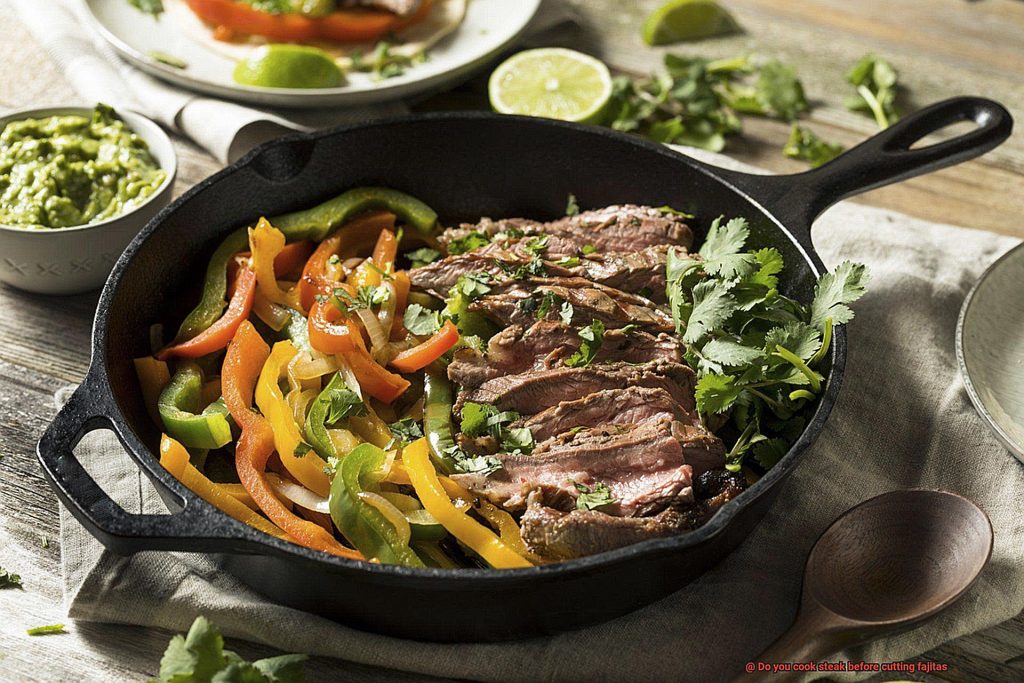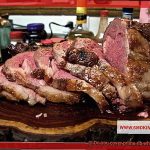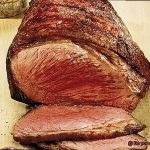Are you a die-hard fan of Mexican cuisine? If the answer is yes, then you must have tasted the delectable fajitas loaded with juicy steak, peppers, onions, and some spices that tantalize your taste buds. But here’s a million-dollar question that has left many home cooks and foodies perplexed – Do you cook steak before cutting fajitas?
Well, don’t fret. The answer to this question is not as simple as it may seem. Some people swear by cooking the entire steak before slicing it into thin strips for fajitas, while others suggest that it’s best to slice the steak first and then cook it in a pan with some spices before adding veggies. But which method is correct?
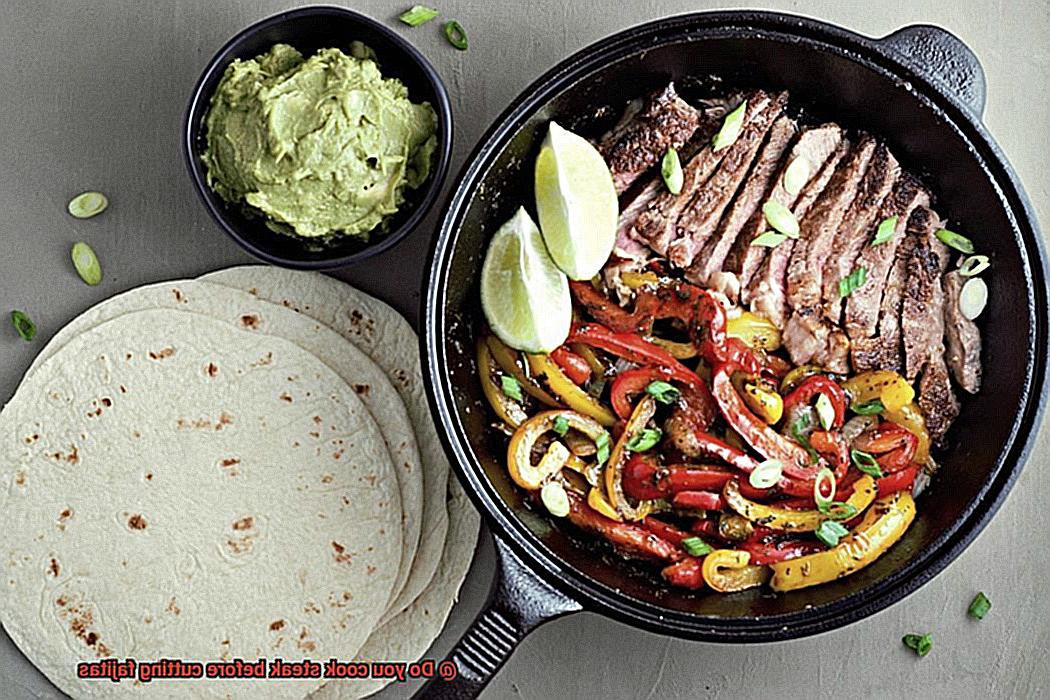
In this blog post, we aim to explore this topic in detail and provide an answer once and for all. We’ll discuss the pros and cons of both methods and explain which one works best. Moreover, we’ll share some useful tips to help you cook the perfect steak for your fajitas.
So, if you’re a foodie looking to master the art of cooking scrumptious fajitas, then buckle up. This post will take you on a culinary journey like no other. Keep reading to find out more about the best way to cook steak for fajitas.
Contents
What is Fajitas?
Fajitas are a popular Mexican dish that have become a staple in Tex-Mex cuisine. They consist of grilled meat, typically beef, chicken, or shrimp, served on a sizzling hot plate with onions and peppers. The term “fajita” actually refers to the cut of meat used, which is the skirt steak.
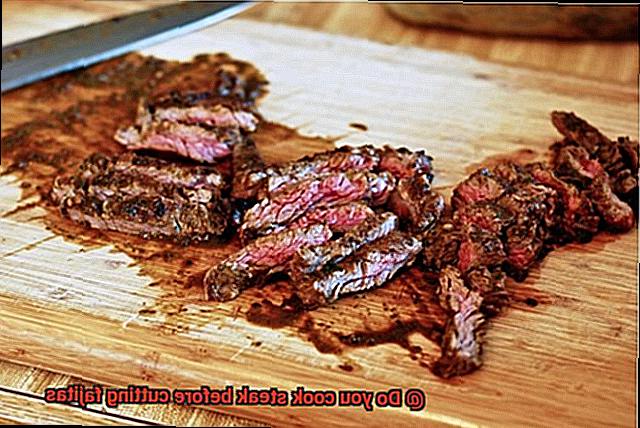
Traditionally, fajitas were made with tough cuts of meat that were marinated and grilled to make them tender and flavorful. The meat was then sliced thinly against the grain to make it easier to chew. Nowadays, more expensive cuts of beef like flank steak or sirloin are used in the United States. The meat is usually marinated in a mixture of lime juice, garlic, cumin, and chili powder before being grilled or seared in a cast-iron skillet.
When it comes to serving fajitas, they can be paired with a variety of toppings such as guacamole, sour cream, shredded cheese, salsa, and fresh cilantro. The fajitas are often wrapped in warm tortillas and served with rice and beans on the side for a complete meal.
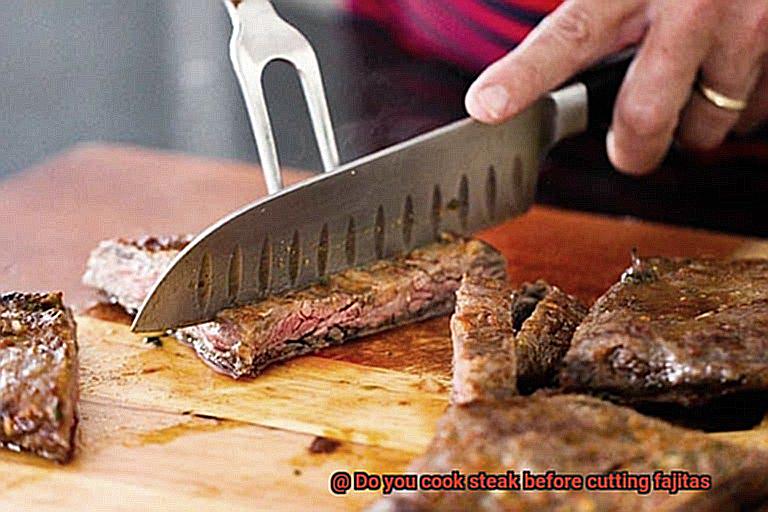
But the question remains – do you cook steak before cutting fajitas? Some experts argue that cooking the steak whole and then slicing it against the grain allows for even distribution of juices throughout the meat resulting in a more flavorful and juicy fajita. Additionally, cooking the steak whole offers more control over the level of doneness since each slice may cook differently.
On the other hand, others believe that slicing the steak before cooking can allow for more even cooking and seasoning. By cutting the meat into thin strips beforehand, it can be marinated and seasoned more thoroughly, resulting in a more flavorful fajita. Slicing the steak beforehand can also reduce cooking time and make it easier to achieve the desired level of doneness.
Ultimately, whether to cook steak before cutting fajitas is a matter of personal preference and cooking style. It is important to consider the cut of steak being used, as well as desired level of doneness and flavor. Experimenting with both methods can help determine which works best for individual tastes and preferences.
Benefits of Cooking Steak Whole
As a fajita aficionado, you’ve probably wondered whether to cook the steak whole or slice it beforehand. As an expert in this field, I can confidently recommend cooking the steak whole. Not only does it result in a more succulent and flavorful fajita, but it also offers numerous other benefits.
Firstly, cooking the steak whole allows you to have more control over the cooking process. By keeping the steak intact, you can ensure that it cooks evenly on all sides and retains its juices throughout the cooking process. This results in a more tender and scrumptious final product. This is especially important when working with tougher cuts of meat that require a longer cooking time to break down and become tender.
Another advantage of cooking the steak whole is that it makes it easier to achieve the desired level of doneness. When slicing the steak into strips before cooking, it can be challenging to monitor the internal temperature of each piece and ensure that they are all cooked evenly. By cooking the steak whole, you can use a meat thermometer to check the temperature throughout the cooking process and make adjustments as needed.
Cooking the steak whole also saves time and makes your cooking process more efficient. Since the steak only needs to be cooked once, instead of multiple times in batches of strips, it can be quicker overall. Additionally, by resting the cooked steak before slicing it for fajitas, you can allow the juices to redistribute throughout the meat and prevent it from drying out during subsequent cooking.
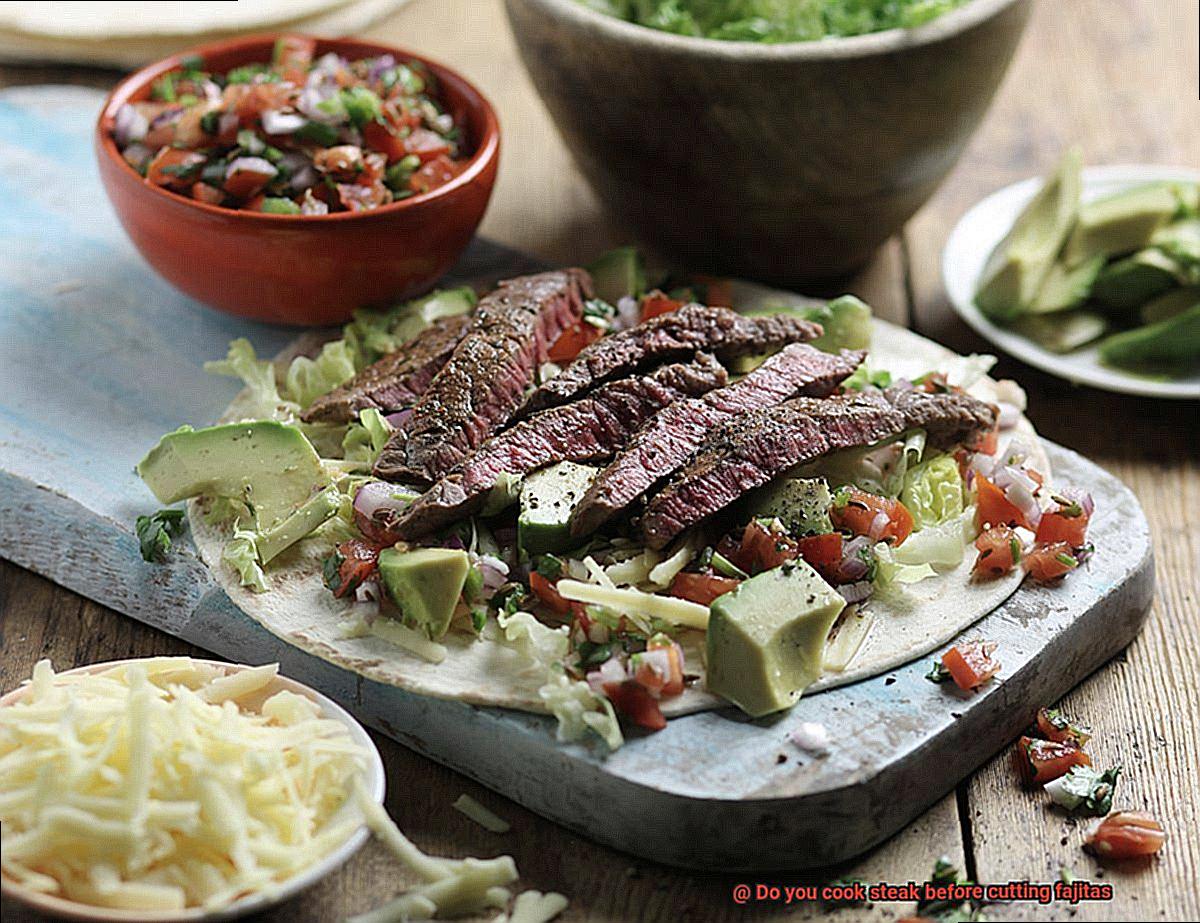
To sum up, cooking your steak whole before cutting it for fajitas is definitely worth considering. Here are some benefits you’ll enjoy:
- More control over the cooking process
- A more succulent and flavorful final product
- Easier to achieve desired level of doneness
- More efficient cooking process
Benefits of Slicing Steak Before Cooking
Not only does it make cooking quicker and more even, but it also enhances the flavor and presentation of your meal.
- Let’s start with the basics – slicing steak before cooking allows for more efficient and faster cook times. No more waiting anxiously for that thick piece of meat to cook through while your vegetables grow cold and unappetizing. By cutting the steak into thin strips, you can ensure that every piece cooks evenly, resulting in a perfectly cooked and juicy fajita.
- But the benefits don’t stop there – slicing steak before cooking also allows for better flavor absorption. When the steak is cut into strips, marinades and seasonings can easily penetrate every inch of the meat, resulting in a more flavorful and tender fajita. Trust me, your taste buds will thank you.
Another advantage of slicing steak before cooking is its ease of assembly. No more struggling to tear apart a giant hunk of meat with a fork and knife. The sliced pieces can be easily portioned and placed on top of tortillas or mixed with sautéed vegetables for a delicious and satisfying meal. Plus, it just looks prettier on the plate.
Finally, let’s talk about portion control – by slicing the steak into smaller pieces, it’s easier to serve up healthy portion sizes without overindulging. Whether you’re watching your calorie intake or just want to keep things in check, slicing your steak beforehand allows you to control how much you consume.
Factors to Consider When Deciding Whether to Cook Steak Before Cutting Fajitas
As a fajita aficionado, you may find yourself grappling with the age-old question of whether to cook your steak before slicing it for this beloved dish. Fear not. As an expert in this area, I’m here to provide some guidance on the factors that should inform your decision.
First and foremost, consider the thickness of your steak. If it’s too thick, slicing it raw may not be the best option. Cooking it first can help ensure even cooking throughout the meat, while also providing a perfectly seared exterior.
Next up, take into account the cooking method you plan to use. Grilling your steak? Slicing it raw is perfectly fine since you’ll have direct heat on both sides of the meat. But if you’re using a stovetop skillet or pan, cooking the steak first can help guarantee even cooking throughout.
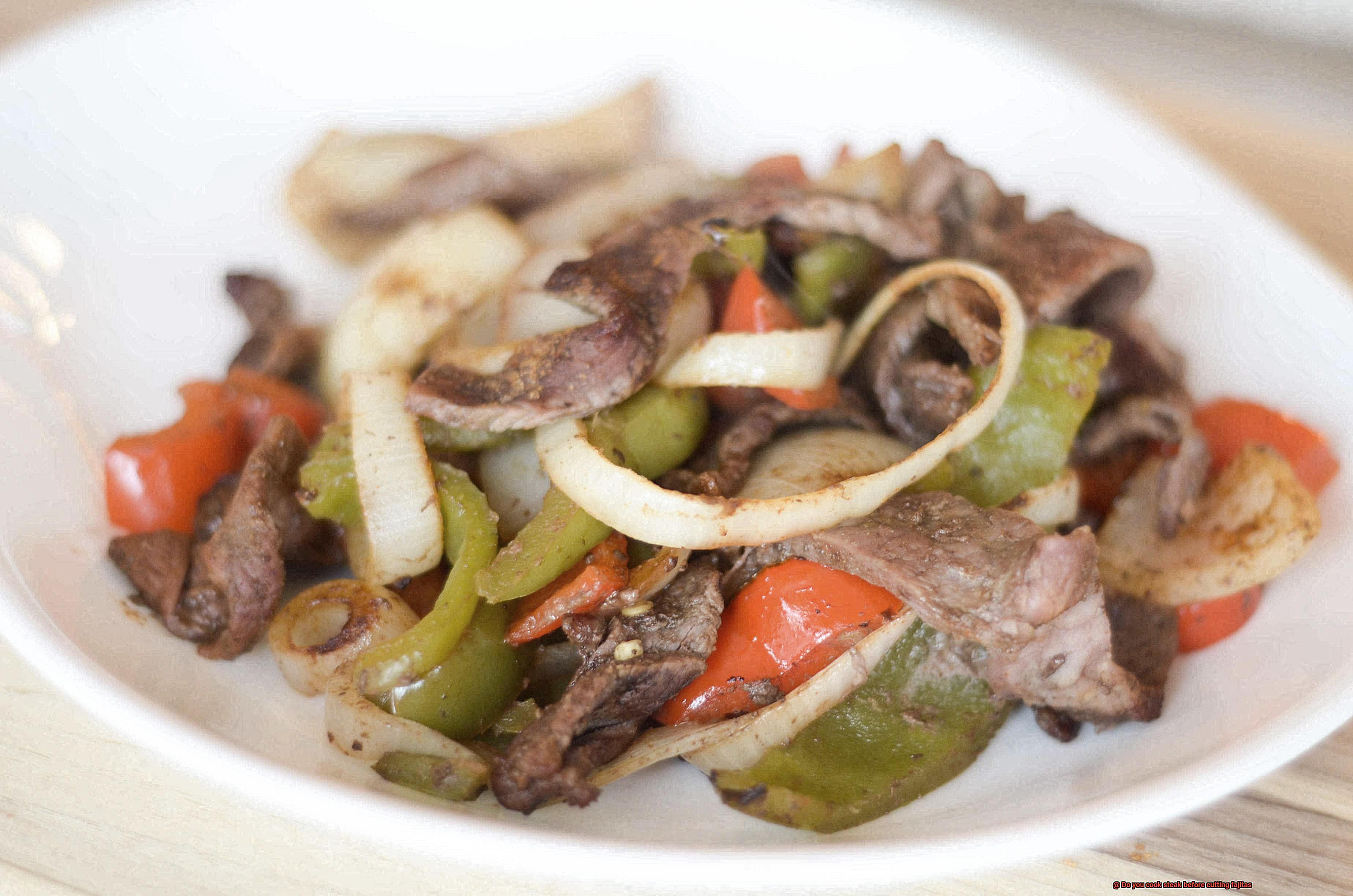
The type of cut of steak you’re using is another crucial factor to consider. Tougher cuts of meat such as flank steak or skirt steak benefit from being marinated before cooking. In this case, it’s recommended to cook the steak first so that it has sufficient time to absorb all of the flavors from the marinade.
Last but not least, your personal preference plays a significant role in deciding whether to cook the steak before slicing it for fajitas. Do you like your meat rare or medium-rare? Slicing it raw and quickly cooking it on high heat may achieve your desired level of doneness. Prefer your meat well-done? Cooking it first can ensure that it’s fully cooked through.
Tips for Cooking the Perfect Fajita Steak
Choose the Right Cut of Meat
The foundation of any great fajita is the steak itself. But not all cuts are created equal. Skirt, flank, and sirloin are all excellent choices for fajitas. They are lean, flavorful, and can be cooked to perfection on the grill or in a skillet.
Marinate for Extra Flavor
If you want to take your fajita steak to the next level, marinating is key. A simple marinade of lime juice, garlic, cumin, and chili powder can add a ton of flavor to your meat. For best results, marinate your steak for at least a few hours or even overnight.
Let the Steak Come to Room Temperature
Before cooking your fajita steak, make sure it has come up to room temperature. This ensures that it will cook evenly and retain its juices, resulting in a tender and juicy final product.
Grill or Pan-Sear
There are two main methods for cooking fajita steak: grilling and pan-searing.
If you’re grilling, preheat your grill to high heat and oil the grates before placing the meat on them. Cook the steak for 4-5 minutes per side for medium-rare or 6-7 minutes per side for medium.
If you’re pan-searing, heat a tablespoon of oil in a large skillet over high heat and cook the steak for 3-4 minutes per side for medium-rare or 5-6 minutes per side for medium.
Rest and Slice
Once your fajita steak is cooked to perfection, let it rest for a few minutes before slicing it against the grain into thin strips. This ensures that each bite is tender and flavorful.
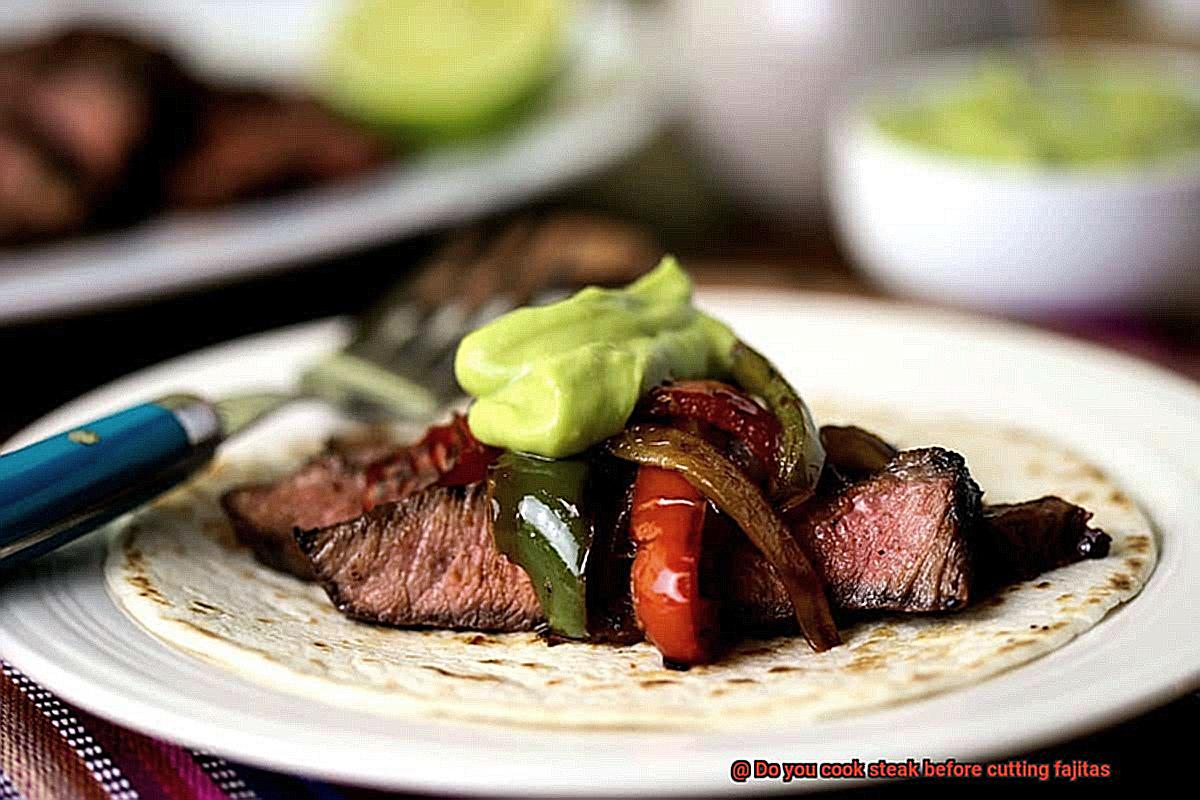
Serve and Enjoy
Now that you have your perfectly cooked fajita steak, it’s time to assemble your fajitas. Add the steak to a sizzling hot skillet with peppers and onions, and serve with warm tortillas, guacamole, salsa, sour cream, and any other desired toppings.
Different Cuts of Meat Suitable for Fajita Steaks
While skirt steak is the go-to choice for fajitas, there are other cuts that can make for an equally delicious and tender meal. Here are some options to consider:
Skirt steak is the traditional cut for fajitas, and for good reason. This thin, long beef cut comes from the diaphragm muscle and is packed with flavor. It’s perfect for a quick sear over high heat, but be careful not to overcook it or slice it against the grain, or else it can become tough.
If you’re open to alternatives, flank steak is another popular choice. It’s a leaner cut that comes from the abdominal muscles and has a similar texture to skirt steak. To ensure tenderness, marinate it before cooking and slice against the grain.
Sirloin is a tender cut of beef that comes from the back of the cow and has a mild flavor. Unlike skirt or flank steak, sirloin doesn’t need to be marinated before cooking. However, it’s still important to slice it against the grain.
For those willing to splurge, ribeye is a flavorful cut that comes from the rib section of the cow. It’s tender and can be cooked quickly over high heat. However, it’s also expensive compared to other options.
How to Slice the Steak Against the Grain
Slicing steak against the grain is a fundamental technique that can make all the difference when it comes to achieving tender, juicy, and flavorful fajitas. But how do you do it correctly? Here’s a step-by-step guide to help you slice your steak like a pro:
Find the Grain
Before slicing your steak, it’s essential to identify the direction of the muscle fibers or “grain.” Look for the parallel lines that run through the meat. These lines indicate the direction of the grain.
Cut Against the Grain
Once you’ve found the grain, use a sharp knife to cut perpendicular to it. Avoid cutting parallel to the lines as this will result in tough and chewy meat. Cutting against the grain helps break up those muscle fibers, making your fajitas more tender and enjoyable to eat.
Slice Thinly
To achieve optimal tenderness, aim for thin slices that are about 1/4 inch thick or less. Cutting too thick can result in tougher and chewier fajitas.
Cut at an Angle
When slicing your steak, try to cut at a slight angle rather than straight up and down. This creates more surface area on each slice, allowing for even cooking and a better sear on the outside.
Practice Makes Perfect
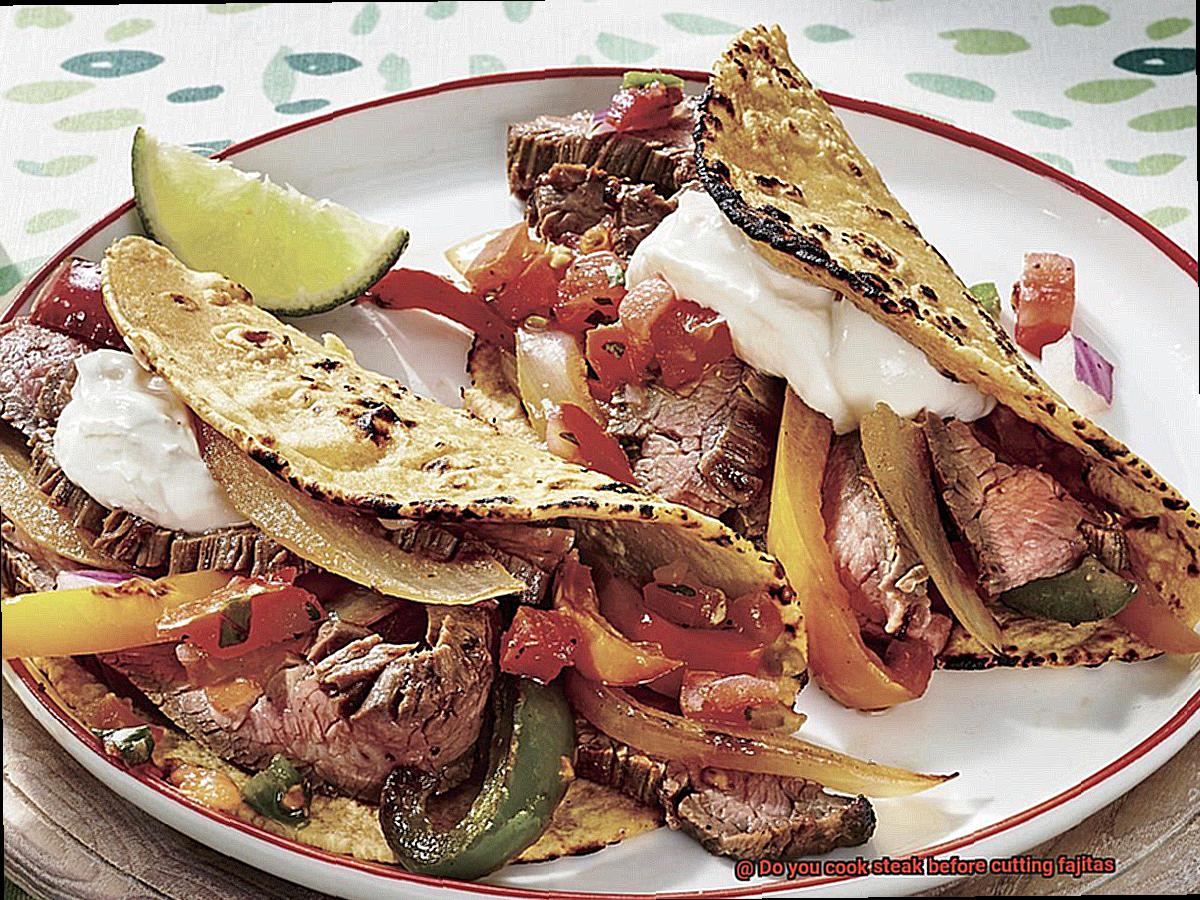
Slicing against the grain may take some practice. Don’t get discouraged if it doesn’t come easily at first. Keep practicing until you can slice with confidence and precision.
Marinating and Seasoning Techniques for Fajita Steaks
Look no further than mastering the art of marinating and seasoning your steak.
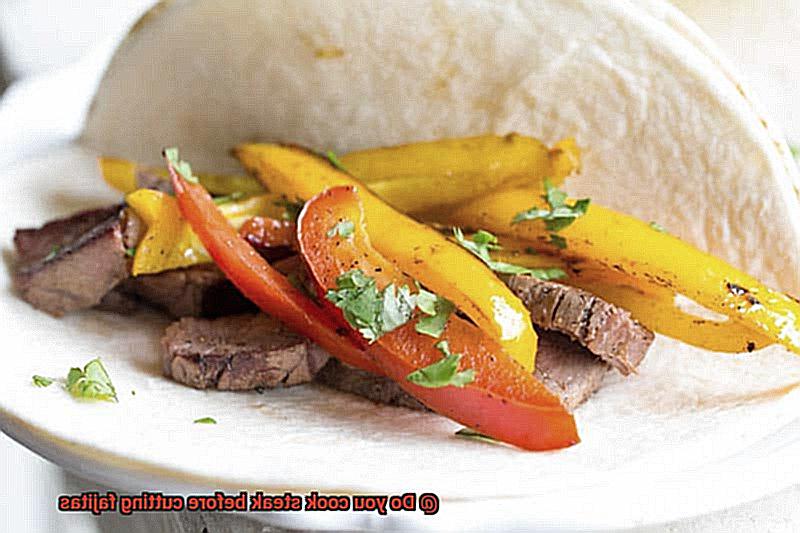
Marinating is the first crucial step in transforming your steak into a delicious fajita. The right marinade is key, and options like citrus juices, vinegar, soy sauce, and spices like cumin and chili powder can elevate your steak’s flavor profile. Remember to let it marinate for at least a few hours, or even overnight, so that the flavors can fully permeate the meat. Trust us, your patience will be rewarded.
Seasoning your steak before cooking is equally important. A simple blend of salt, pepper, and garlic can go a long way in enhancing the taste of the meat. For those who like a little extra heat, try adding some paprika or cayenne pepper for an added kick.
When it comes to cooking the steak, remember to cook it whole before slicing it into strips for your fajitas. This ensures even cooking and prevents the meat from becoming tough or dry. And once it’s cooked, let it rest for a few minutes before slicing against the grain into thin strips. This technique ensures each piece is tender and juicy–the hallmark of any great fajita.
RhyK-_VIiek” >
Conclusion
In conclusion, the age-old question of whether to cook steak before cutting fajitas is a topic that sparks debate among foodies and chefs alike. While both methods have their pros and cons, it ultimately comes down to personal preference and cooking style.
Cooking the steak whole offers the advantage of greater control over the cooking process and more even distribution of juices throughout the meat. This results in a more flavorful and juicy fajita, as well as an easier time achieving your desired level of doneness. Additionally, this method can be more efficient when cooking for a large group.
On the other hand, slicing the steak before cooking allows for more even seasoning and quicker cooking times. This method also makes assembly and portion control easier.
To ensure your fajita steak is cooked to perfection every time, start by choosing the right cut of meat. Skirt or flank steak are great options due to their lean yet flavorful nature. Marinating your steak for at least a few hours (or overnight) can also add an extra layer of flavor.
When it comes time to cook your steak, remember to let it come to room temperature before grilling or pan-searing it. And after it’s done cooking, be sure to let it rest for a few minutes before slicing against the grain into thin strips.
Finally, don’t forget about seasoning. A simple marinade with citrus juices, vinegar, soy sauce, cumin, chili powder can take your fajita game to new heights. And adding salt, pepper, garlic powder can really bring out those delicious flavors.

